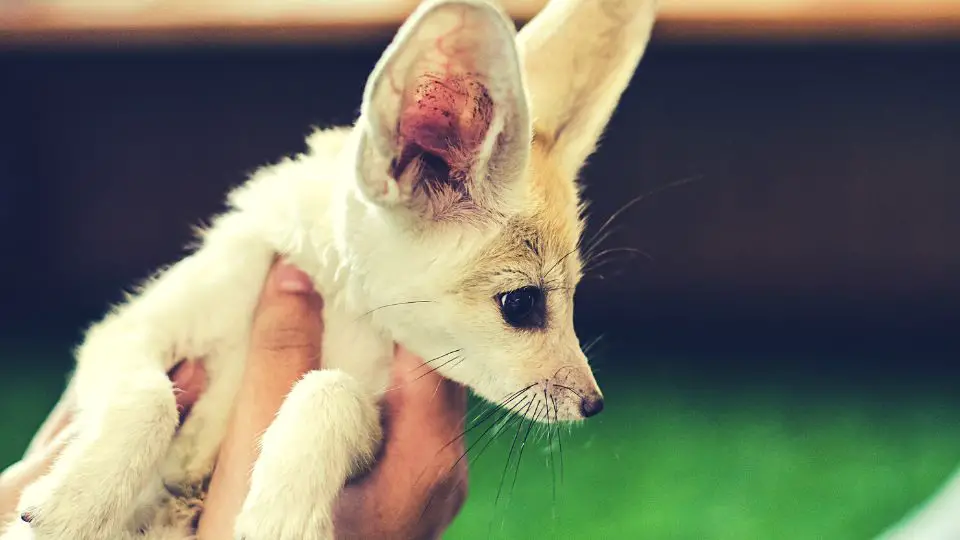While these small foxes are well adapted to hot and dry environments, their ability to handle cold weather is limited. Fennec foxes are native to the Sahara desert and other arid regions of North Africa, where temperatures can reach over 100 °F (ca. 38 °C) during the day and drop below freezing at night.
Therefore, keeping a fennec fox as a pet in a cold climate may not be suitable, and it could be considered cruel if proper measures are not taken to keep them warm and safe.
In this article, we will examine the challenges that fennec foxes may face in cold weather and provide tips on how to keep them safe and healthy in a colder climate.
Can Fennec Foxes Live in Cold Weather?
Fennec foxes are native to the Sahara desert and other arid regions of North Africa, where temperatures can reach over 100 °F (ca. 38 °C) during the day and drop below freezing at night. Due to their desert origins, fennec foxes are well adapted to hot and dry environments, but how well can they cope with cold weather?
While fennec foxes are adapted to handle extreme heat, they may struggle in cold weather, as their small size and thin fur coat do not provide much insulation. Fennec foxes are also not hibernating animals, which means they cannot go into a state of dormancy to avoid the cold.
In the wild, fennec foxes have adapted to colder temperatures by burrowing underground during the coldest parts of the day and emerging during the warmer periods. However, as pets, fennec foxes may not have access to natural burrows or other sources of warmth during colder weather, which can put their health at risk.
Therefore, it’s important for fennec fox owners to take extra precautions during the colder months to ensure their pet’s health and well-being. This includes providing a warm and comfortable indoor living environment, monitoring the temperature of their living area, and making sure they have access to plenty of warm bedding and shelter.
What temperature do fennec foxes live in?
Fennec foxes are native to the Sahara desert in North Africa, where temperatures can reach up to 104 °F (40 °C) during the day and drop to around 68 °F (20 °C) at night. They have evolved to tolerate extreme heat and can maintain a stable body temperature despite the desert’s harsh conditions. In general, fennec foxes are not well-suited to living in colder climates as they are not adapted to withstand low temperatures.
Are fennec foxes warm or cold blooded?
Fennec foxes are warm-blooded mammals, which means they can regulate their body temperature internally to adapt to their environment. However, they are better adapted to warm environments due to their ability to dissipate heat quickly through their large ears and lack of sweat glands.
What weather do fennec foxes like?
Fennec foxes prefer warm and dry climates, but they can adapt to colder weather with proper care and accommodations. In the wild, they have adapted to survive in a wide range of temperatures and can burrow into the ground to stay warm during the night.
However, it is important for pet owners to provide them with a suitable and warm living environment if they live in colder regions.
Understanding Fennec Fox Adaptability
Fennec foxes have evolved and adapted to survive in their native desert habitat, where extreme temperatures are common. Their physical characteristics, such as their large ears, thin fur, and small size, allow them to regulate their body temperature and conserve water.
Those large ears help them dissipate heat and stay cool during the hot day and cold nights of the desert. Their thin fur helps them stay cool in the hot sun and warm in the cold nights. They are also small in size, which allows them to lose less heat and conserve water.
In terms of temperature, fennec foxes can tolerate a wide range of temperatures, from below freezing to over 100°F. However, they do have a temperature range where they are most comfortable, which is between 68 °F (20 °C) and 86 °F (30 °C). In the wild, they dig underground burrows to escape extreme temperatures and regulate their body temperature.
What does a fennec fox need to survive?
To survive, fennec foxes require a few key things. They need access to water, which they can obtain from their diet or by digging for it in the ground. They also require a diet that is high in protein and low in carbohydrates, consisting of insects, small mammals, birds, and plant material. Additionally, they need a safe and secure place to rest and escape predators.
While fennec foxes are well adapted to their native environment, they may struggle to adapt to other climates, such as those with colder temperatures and higher humidity. Therefore, it’s important for prospective pet owners to understand the needs and requirements of fennec foxes before bringing them into different climates or environments.
Can You Keep a Fennec Fox as Pet in a Cold Area?
Keeping a fennec fox as a pet in a cold area requires special considerations due to their natural desert habitat. While fennec foxes can adapt to colder temperatures, you have to provide them the proper environment and care.
One concern is the need for a warm and dry living space. Fennec foxes require a consistent temperature of at least 68 °F (20 °C) to prevent them from becoming too cold, as they do not have a thick layer of body fat to keep them warm. Additionally, you have to keep their living space dry and well-ventilated to prevent respiratory problems.
Providing adequate nutrition and hydration is crucial. In cold temperatures, fennec foxes may require additional calories to maintain their body temperature, so their diet should be adjusted accordingly. Fresh, clean water should be available at all times, and it’s important to regularly check and refill the water to prevent it from freezing.
Note that keeping a fennec fox as a pet in a cold area may be considered cruel, as it goes against their natural habitat and could cause them undue stress and health problems. It’s essential to carefully consider the well-being of the animal and ensure that their needs are being met before making the decision to keep them as a pet in a colder climate.
If you do decide to keep a fennec fox as a pet in a cold climate, here are some tips to help ensure their health and well-being:
- Provide a warm and dry living space with a consistent temperature of at least 68 °F (20 °C).
- Ensure proper ventilation to prevent respiratory problems.
- Adjust their diet to provide additional calories to maintain body temperature.
- Provide fresh, clean water at all times, and regularly check and refill to prevent freezing.
- Monitor their behavior and health closely, and seek veterinary care if needed.
Overall, while it is possible to keep a fennec fox as a pet in a colder climate with the proper care and environment, it’s important to carefully consider the animal’s needs and well-being before making the decision.
Conclusion
In conclusion, fennec foxes are well adapted to their native desert environment, but they may struggle to adapt to colder climates with higher humidity.
As such, it’s important for prospective pet owners to understand the needs and requirements of fennec foxes before bringing them into different climates or environments. While it is possible to keep a fennec fox as a pet in a cold area, providing adequate nutrition and hydration along with a warm and dry living space are essential for the animal’s health and wellbeing.
Ultimately, careful consideration must be taken before making the decision to keep one in an unnatural climate.







